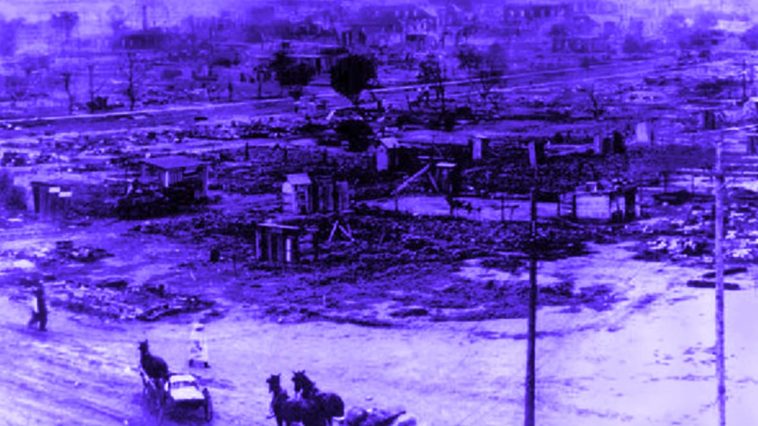
A lawsuit filed on behalf of survivors of the 1921 Tulsa Race Massacre recorded a victory on Monday when a judge allowed the case to move forward even though the defendants argued that the case should be dismissed. The main point of this case, according to survivors, is to undo the harm and injustice the community has suffered. The survivors argue there is no time limit on justice when there is continued harm even a hundred years later.

293 Views
Comments Off on Tulsa Race Massacre Reparations Lawsuit Moving Forward With Judge’s Ruling
Moving Forward
Following a motion to dismiss the case, plaintiffs who were seeking reparations for the 1921 Tulsa Race Massacre celebrated a judge’s ruling on Monday allowing their case to move forward.
Judge Caroline Wall stated the motion to dismiss was “granted in part” and “denied in part.” This means the case can move forward: however, it is not certain what will happen next, including details on a potential trial, according to Michael Swartz, who is one of the attorneys for the plaintiffs.
The plaintiffs’ attorneys pleaded on Monday afternoon for the judge to allow the case to move forward so survivors and descendants of victims from the massacre could have their day in court, as well as some form of justice.
“I’ve never seen nothing like this happen,” said Hughes Van Ellis, a 101-year-old survivor of the massacre, to CNN. “That means it’s going to change things. It’s going to make people think … It’s going to change, it’s going to be better for everybody.”
The lawsuit itself was filed in March 2021. The intent of the lawsuit aimed to both set the historical record on what happened between May 31 and June 1, 1921 and create a special fund for survivors and descendants of the massacre that left at least 300 Black people dead and the neighborhood of Greenwood destroyed.
Attorneys for the plaintiffs are also fighting the passage of time, as three of their clients are more than 100 years old. Damario Solomon-Simmons, another attorney for the plaintiffs, told CNN Monday today’s victory followed a long string of defeats.
“When you work on something for 20-plus years, you have defeat after defeat … you have client after client die. To know I have three living survivors that are here with me right now feel this partial victory, it means everything,” Solomon-Simmons said.
According to Solomon-Simmons, Wall’s decision became the basis for future cases of similar discrimination and allowed him to hold America accountable for an injustice committed 100 years ago.
“It shows a precedent and model of how you can organize a community, how you can organize your colleagues and partners throughout the nation,” he said. “This victory we’ve received is because of so many people working together from across this nation and building coalitions,” he added.
Defendants Named
Eleven plaintiffs were named in the lawsuit, which included survivors and relatives of survivors. Seven total defendants are named, including the city of Tulsa, Oklahoma Military Department and the Tulsa Development Authority.
Six months after the lawsuit was initially filed, several defendants in the case, one of them being the Board of County Commissioners and Tulsa Metropolitan Area Planning Commission, filed motions to dismiss. Arguments included that the case lacks standing because some plaintiffs have not proven they suffered concrete personal injury and alleged injuries could not be remedied by the court. A hearing was held in September, but no decision was made.
A judge gave plaintiffs a deadline of January 31 to present new arguments and gave defendants until March to respond, Solomon-Simmons said.
“We asked her for another hearing day because mother (Viola) Fletcher turns 108 on May 10, and we asked Judge Wall and … we said, ‘Look, this issue needs to be resolved before this lady turns 108 years old.’ And that’s why she granted that hearing,” said Solomon-Simmons.
In addition to correcting the historical record and creating a fund for survivors and descendants, the lawsuit is looking to officially declare the actions of that day and the century that followed after the riots “created a public nuisance” for the plaintiffs and their descendants as defined by Oklahoma law. The next steps after Monday’s hearing would be the discovery stage or the gathering of more evidence.
“And that’s why this is so important. There’s so much we don’t know about the massacre. There’s so much, we don’t know about the ongoing harm,” Solomon-Simmons said.
John Tucker, a representative of the Tulsa Chamber, argued Monday that a charge of public nuisance is unable to address societal ills.
He also quoted from the November ruling where the Oklahoma Supreme Court reversed a court decision that ordered Johnson & Johnson to pay $65 million to Oklahoma for its role in the opioid crisis.
“We hold that the district court’s expansion of public nuisance law went too far,” Oklahoma Supreme Court Justice James Winchester wrote in his opinion at the time while adding the state’s public nuisance is not applicable to the opioid pandemic.
Tucker also argued the massacre happened too long ago to warrant a charge of public nuisance. Plaintiffs compared the massacre to an oil spill that has long-term effects, Tucker disagreed, arguing the massacre can’t be likened to an oil spill that’s still on the ground and causing harm.
He then argued it’s a matter to be addressed by other branches of government, not the courts, and the judge would be overstepping the legislature’s mandate by allowing this case to go to trial.
A Brief History Of Tulsa
Before the riots, the Greenwood District was a thriving Black hub of commerce, home to multiple millionaires and about 300 Black-owned businesses. It was known as “Black Wall Street.”
On May 30, 1921, Dick Rowland, a 19-year-old Black shoe shiner, ran from an elevator in a downtown building after the elevator’s teen operator let out a scream. When rumors of rape had been circulated, Rowland was arrested, and White Tulsans formed a lynch mob.
Black Tulsans arrived at the jail to defend Rowland. A fight then occurred, a gun went off, and as then-Sheriff William McCullough told Literary Digest, “All hell broke loose.”
The mob destroyed about 35 blocks within 16 hours, arresting thousands of Black residents, while robbing, beating and killing others. Historic photos show entire blocks gutted by flame and Black people lying in the street.
Matters were then worsened when insurance companies denied many claims for what today would be tens of millions of dollars in property damage, including the destruction of two Black hospitals and 1,256 residences, according to the Greenwood Cultural Center.
“There is still no hospital in north Tulsa today. So that’s 101 years that that hospital has never been rebuilt,” Solfanelli said. “When you think about the generational wealth that was lost when Greenwood was lost, then I think people can step back and say, ‘Wait a minute, imagine if that happened to my great-grandparents.’”
“It’s special because of the size and scope of the destruction. It’s special because we have so much documentation, we have actual video, we have hundreds of pictures, we have hundreds of insurance claims that were not paid, and we have three living survivors,” he said. “If Black people can’t win this, how can we win?”
Harvard University Addresses Ties To “Entanglement” In Slavery
Harvard University will be committing $100 million to study and redress its ties to slavery. This is alongside plans for reparations and assessing how many were enslaved by Harvard figures.
Harvard University plans to invest $100 million to study and redress its past ties to slavery in the United States. This was announced on Tuesday by Lawrence S. Bacow, Harvard University president.
Bacow said Harvard would create a “Legacy of Slavery Fund,” which will continue to research and memorialize that history. This would be conducted alongside descendants of Black and Native American people enslaved at Harvard and its broader communities.
